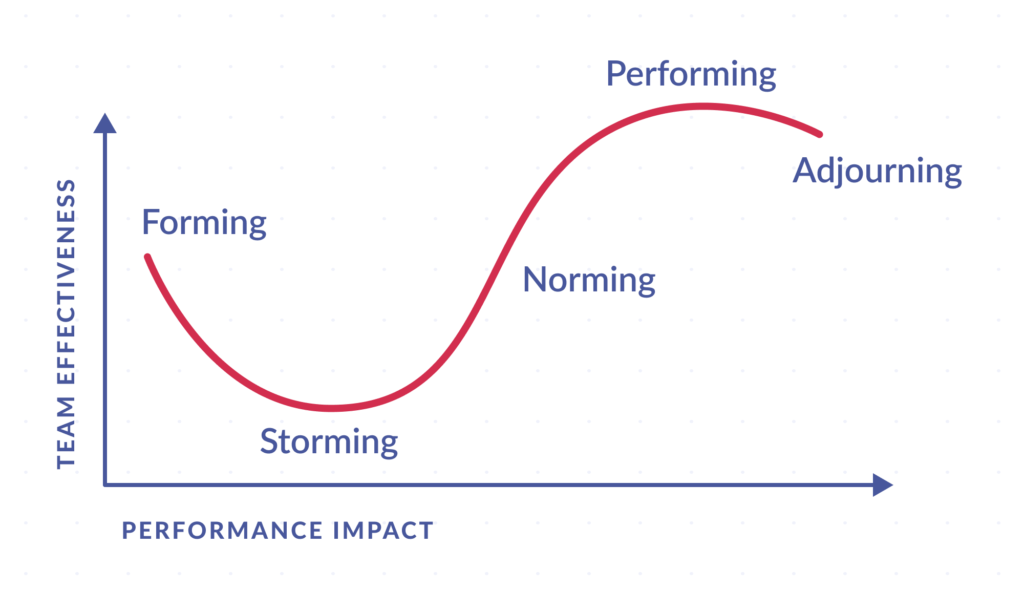Forming, Storming, Norming, & Performing: The Storming Stage
For a lot of us, March 2020 was a moment when our normal way of working dramatically shifted. Colleagues who used to work seamlessly together were now struggling to stay in step with one another. Even previously high performing teams were thrown into disarray. Our previous ways of working as a team just weren’t possible anymore. We needed to create new team ‘norms’ and practices.
But the need to come back together to reestablish ways of working together is not specific to the Coronavirus pandemic. Even in ‘normal’ times, creating team norms is something that every team has to do if they want to reach high performing status. That being said, Q2&Q3-2020 have been a time of exceptional change and Q4 is looking to be just as tumultuous. If we want to not only weather the storm, but thrive in it, we need to adapt to this new reality and recognize that the definition of a high performing team has evolved.
But helping the team create new norms and ways of working together isn’t just the role of the team leader. All team members should take ownership of how the team is working together, and be willing to put in the effort to improve its overall performance. It is for that reason that I wanted to do a series on how to build team effectiveness. My goal with these articles and tools, is to help you get back to high performance as quickly as possible.
Forming, Storming, Norming, & Performing: The Storming Stage
The 5 stages of high performing teams

While there are many different team effectiveness models, one of the most practical is the Forming-Storming-Norming-Performing model created by Bruce Tuckman in 1965. Tuckman’s model was compiled by comparing the results from 50 different research studies on small team development. There are 5 main stages that every team goes through, or re-goes through in the case of adding a new member to the team. They are:
Forming
The first stage is when the team is initially coming together (or when a new member joins). In this stage, team members can range from positive excitement to anxious energy. During this first stage, team members are learning more about each other and also about what the team is meant to accomplish. The team spends a lot of time discussing the different tasks at hand, how to approach them, and what roadblocks they might face. In order to move to the second stage, team members will need to trust each other enough in order to challenge each other’s ideas and have healthy conflict.
Storming
The second stage of a high performing team, occurs after the team has aligned around the basics (who we are, what we are doing, etc…), and instead focuses on voicing opinions and debating ideas. We call this stage ‘Storming’ because this is the first time where disagreements and personality clashes start to emerge. During the Forming stage everyone is on their best behavior, but in the Storming stage people start being more honest with their thoughts and feelings. The risk of this stage is that some teams can get stuck in a storming mindset. They never resolve their differences, and ultimately the team’s performance suffers.
Norming
If a team is able to resolve its differences and trust continues to be built, then a team can enter the third stage, Norming. At this stage, the team moves past the individual competition amongst the team members, and instead aligns around the common team goals. Team members accept each other (differences included), and a normal way of working together starts to emerge.
Performing
After group norms are established and the team is aligned around common goals, the team can start to reach high performance levels. At this stage, the team members are motivated, excited to be working with the team, and working collaboratively. And since there is high levels of trust, the team freely challenges each other’s ideas and works together to make sure the best idea wins.
Adjourning
The final stage of any team is when the team is coming to a close. Maybe that is because the team has completed its tasks, and the project team is disbanding. Or maybe it’s because a member of the team is leaving the team. But no matter why the team is coming to an end, it is important to recognize and celebrate the team.
Forming, Storming, Norming, & Performing: The Storming Stage
The critical components of the Norming stage

As we wrote in the previous articles, the Forming stage is similar to the honeymoon period of a relationship, and the Storming stage is that annoying time right after the honeymoon period when you realize your new boyfriend/girlfriend isn’t as perfect as you originally thought. But if you are able to accept those negative qualities of your new boyfriend/girlfriend, you might be on your way towards a long and healthy relationship. And the same can be said for team development.
Thanks to the Storming stage, you now know that some of your colleagues have completely different viewpoints than you, and some might be even challenging to work with. Gone are your idealistic beliefs on how everyone on the team will perfectly contribute. But if you are willing to assume the best intent of your colleagues, you will begin to see these differences as valuable components of your team, instead of annoyances.
The following are the key foundations for the Norming stage that will help you reach the high performance of the Performing stage:
Mindset of Assuming Best Intent
It is too easy to judge someone’s actions, especially if that person is still relatively new to you. I know I have fallen into this trap many times. When a new colleague shoots down my idea in a meeting, unhelpful thoughts race through my head. Why doesn’t that person like me? What did I do to offend the person? Since I don’t have a strong relationship with the person, my default reaction is to assume negative intent of their actions.
While this approach makes sense evolutionarily (blindly trusting strangers was a quick way to be taken advantage of) it isn’t a great mindset in your office. Instead of assuming negative intent of your colleague, give them the benefit of the doubt. Assume positive intent of their actions. Maybe the new colleague shot down your idea because they have access to some different data. Maybe they didn’t realize how they were coming across. If you want to get past the Storming stage, then you have to give your team members the benefit of the doubt.
Setting up Teamwork Norms
Once you have the right mindset of assuming positive intent within your team, you can start establishing some clear ways of working together. What topics do you discuss in your regular team meetings? How easily are you able to work on cross team issues? When do people reach out to get the opinions of others? What common processes do we all need to align on? Are there tools we need to all use in the same way?
Sometimes answers to these questions will develop organically in your team. But from my experience, the majority of teams will fall into some bad habits and those habits will get ingrained over time. That is why a key component of the Norming stage is to break any bad habits that started to form in the Storming stage and establish productive ways to collaborate.
Here are some different examples of how a team needs to establish standard ways of working together:
- Standardized processes – A team cannot work together if everyone is working off of a different set of processes. While this may not be a big issue on your immediate work team, different processes can cause huge issues on cross functional teams or when working with people outside your organization.
- Common tools – Teams benefit from using the same type of work tools, especially those designed to help people collaborate. For example, both of the Office 365 and G-Suite products are great tools to help your teams work on shared documents and presentations. But your team will not gain the benefit of these tools if half your people are using Word while the other half are using Google-Docs. I know I personally prefer the Office 365 tools, but for the sake of my team, I switched over to the G-Suite products.
- Collaboration Norms – Finally, it is important that you and the team agree on some collaboration best practices. How will you act in meetings? How will you work together in projects? When will you seek input from each other? These kinds of questions are critical to establishing collaboration best practices.
Forming, Storming, Norming, & Performing: The Storming Stage
Exercises and Tools that will help your team in its Norming stage

There are many different tools that you can use to build team effectiveness during the Norming stage. Here are 3 of my top recommendations:
Identify Your Best Communication Practices
All teams (especially virtual teams) need to be more upfront and overt with their ways of working together. They need to come together as a team, and establish some practices that everyone will commit to. By setting these common standards up front, you can help improve communications amongst your team, decrease conflicts and misunderstandings, and overall increase your team’s productivity. In essence, this exercise will help you in moving past the Storming stage and into the Norming stage.
Additionally, it is important to recognize that remote teams might need even more help in setting communication best practices. For example, working remotely can sometimes feel very lonely. It is important when creating these team standards, that you and the team address how to stay connected as a team on a personal level. Interacting with colleagues in an office is never 100% about business. So make sure your virtual meetings and video chats similarly include personal topics as well.
Setting our Rules of Engagement
Team norms is not something that just one person can decide, even if you feel like you know what’s best for your team. Team norms can only be created by the team as a whole. The team needs to set your team’s values, build your team’s culture, and discuss the behaviors you will expect from one another. That is why we recommend that you and your team collaboratively define the rules that you will all live by.
Click here for a step by step guide on how to define your team’s Rules of Engagement.
Driving for Alignment in Your Meetings
It is estimated that US companies waste $37 billion in unnecessary meetings every year. Let that sink in for a second. US companies waste $37 billion from having unproductive meetings! And this figure does not include the impact and costs of people walking out of meetings misaligned or without a clear decision. So, what can you do about it? The best approach I have seen so far are the Drive for Alignment actions.
Driving for Alignment in meetings is comprised of these 4 actions:
- Frame – In order to have an effective meeting, the first critical action you need to take is to make sure everyone is aligned around the purpose of the meeting or conversation. Too often time is wasted because people are not talking about the same thing, and that is why it is critical to frame the discussion at the beginning to make sure everyone is on the same page.
- Build & Credit – In normal meetings, most people are just waiting to share their opinion. They aren’t really listening. But when you are trying to Drive for Alignment, the goal should be to build off the ideas of others, and then to give the person credit for that starting point of your idea.
- Align – As the team builds ideas, there will naturally be some areas of alignment. It is critical as a team that you constantly acknowledge what they are aligned on, so the majority of the discussion can focus on the places of disagreement.
- Validate – Before a decision can be finalized, it is critical that the team validates the idea. Too often teams forget this final step, and the meeting ends with a decision that will quickly fall apart.
Click here for more information on how to Drive for Alignment in your team.
Forming, Storming, Norming, & Performing: The Storming Stage
Norming isn’t magic… it’s just work.

The 2 best teams I have ever worked on were the ones where we all gelled. I knew my team members strengths, and where they struggled. In our meetings we tackled challenging topics with enthusiasm, and no one was afraid to challenge each other’s ideas. Our collaboration was so tight that we could practically finish each other’s thoughts.
That kind of high performing teamwork did not just happen magically. I can attest that the managers of these 2 teams spent a lot of time and personal investment in getting the team to work this well together. They didn’t take teamwork for granted. Instead they prioritized the team improving how it could work together. And by establishing positive team norms, these 2 managers were able to help my teams move from the Norming to Performing stage of team effectiveness.
Forming, Storming, Norming, & Performing: The Storming Stage

Leave a Reply